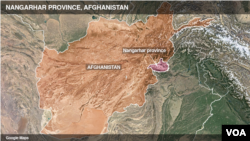Days of fierce clashes between the Taliban and Islamic State terrorists in eastern Afghanistan are reported to have spilled over to adjoining areas, with both sides suffering heavy casualties.
The fighting erupted earlier this week in the Khogyani district of Nangarhar province after IS militants assaulted Taliban-held areas. The clashes forced hundreds of civilians to flee their homes to avoid being caught in the crossfire between the militant groups.
A regional Afghan military spokesman confirmed to VOA the battlefield gains encouraged IS militants to stage overnight assaults against Taliban positions in the adjoining Alingar district of Laghman province, sparking heavy clashes there.
“The fighting has left two key Taliban commanders dead, but we do not have immediate information about IS losses,” he said Thursday.
Provincial officials reported the Taliban is trying to bring in reinforcements from nearby districts in Laghman, while Daesh (IS) militants are also trying to reach the battleground from the group’s major redoubts in Nangarhar and Kunar, another eastern Afghan province where IS is attempting to increase its influence.
But when contacted by VOA a Taliban spokesman said the insurgent group is fighting government forces in Alingar and claimed Daesh does not exist in the area.
The Taliban issued a video Thursday showing the deputy head of the IS Afghan branch, Abdul Razeq Mehdi, joining the insurgency. IS has not yet commented on the Taliban claim.
On Wednesday, the insurgent group accused Afghan and U.S. forces of conducting airstrikes against Taliban positions while it was battling militants from the rival group in Khogyani, enabling IS to make territorial advances.
While clashes between the two militant groups routinely occur in parts of Nangarhar, including Khogyani, IS loyalists have for the first time entered Laghman since their emergence in Afghanistan in early 2015 in Nangarhar under the local name of IS-Khorasan Province, or ISK-P.
Meanwhile, officials in the eastern Afghan province of Logar said Thursday they have arrested 11 Chechens, including women and children, and seized weapons from them.
A provincial government spokesman told VOA an investigation is under way to determine the loyalties of the detainees, from where they arrived in Afghanistan, and what was their mission.
The arrests came a month after at least eight Chechens were killed in fighting with Afghan forces in an another district of Logar. Local politicians say the number of suspected IS foreign fighters has lately increased in the province.
The Afghan branch of the Middle Eastern terrorist group has been from the outset under attack from U.S.-backed Afghan security forces and the Taliban.
IS has also claimed responsibility for numerous recent suicide bombings and other terrorist attacks against Afghan forces and worship places of the minority Shi’ite community, killing hundreds of people.
Afghan officials and residents have also reported IS is expanding its footprints northward in Afghanistan. The commander of U.S. forces in the country, General John Nicholson, on Tuesday, for the first time, backed those reports, saying IS is now active in the northern province of Jowzjan, which borders the Central Asian state of Turkmenistan.
The Afghan province is known for harboring the extremist Islamic Movement of Uzbekistan, which pledged allegiance to IS’s Afghan branch in 2015.
“We are seeing Daesh presence in Kunar and Jowzjan. These are two other provinces, but we think those numbers [of IS fighters] there are small, 300 or less in those areas,” said Nicholson.
The general noted that a “lion’s share” of American airstrikes, increased threefold since August when President Donald Trump unveiled his Afghan war strategy, have focused on IS and significantly reduced the number of its fighters in the country. "But it is like a balloon. We squeeze them in this area, and they will try to move out elsewhere,” explained the U.S. general.








